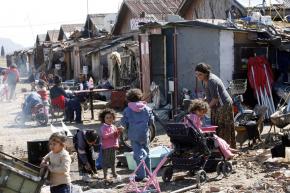Victimizing the Roma again
The persecution of the Roma people continues across Europe with vicious results, writes .
IN NOVEMBER 2007, the Czech Republic was found by the European Court of Human Rights (ECHR) to have discriminated against Roma children by assigning them routinely to schools for pupils with learning difficulties.
The case had been taken by the European Roma Rights Center with the backing of Human Rights Watch, on behalf of 18 Roma children from Ostrava, the second-largest urban area in the country, after Prague.
The ruling came more than 10 years after the case had been launched. The children had had to exhaust Czech legal procedures before having recourse to the Strasbourg court.
The ECHR noted that the treatment of the Roma had not been contrary to Czech law. It observed that "the channeling of Roma children to special schools for the mentally retarded was often quasi-automatic." More than half of the Roma in Ostrava were being consigned to the special schools.
Official discrimination against Roma is par for the course in many European countries today and in line with historical experience.

Since their appearance in Europe as migrants fleeing invasion in northern India around 700 years ago, they have been continuously subjected to intense persecution. Chronicles of the 16th, 17th and 18th centuries record Roma being hunted by posses on horseback and summarily hanged. There are few accounts of anybody standing up for them.
Persecution of Roma in the last century under the Third Reich is reasonably well-known. But the scale of the atrocity is rarely acknowledged.
Between a quarter and a third of Roma in areas controlled by the Nazis, around 600,000 people, were to perish--a higher proportion than of any group apart from the Jews.
The treatment of Roma under Hitler represented an intensification of what had gone before. A Bavaria State law of 1926 required all Roma to register with the authorities and to report their movements to the police. Three years later, the measure was extended to all Germany. Seven months after taking power, in July 1933, the Nazis passed the "Law for the Prevention of Offspring with Hereditary Defects"--a charter for forced sterilization aimed at Roma and Jews. The first "Gypsy camp" was set up in 1936 at Marzahn, near Berlin. Mass round-ups began in 1938.
During World War II, Roma were deported in large numbers to concentration camps including Buchenwald, Dachau, Ravensbruck, Mauthausen and Auschwitz. On one day, August 2, 1944, 4,000 Roma were crammed into the gas chambers at Auschwitz to die.
In Croatia, the Nazi Ustashe, with the open support of a majority of Catholic clergy, massacred many thousands of Roma, Serbs and Jews who refused to convert to Catholicism. (In fairness, the Vatican protested vigorously, if to no effect.)
And likewise across occupied Europe. Thousands were rounded up in Vichy France and sent in batches in cattle trucks to the camps. Tens of thousands were deported with Jews from Romania (quite likely the grandparents and great-grandparents of many of the Roma currently and recently here) to camps in Transistria, now part of Moldova.
TODAY, THE same contemptuous, racist attitude to the Roma persists in parts of Europe. In Kosovo, only 25,000 Roma remain from a population of around 160,000 prior to the conflict of the late 1990s. They live in camps in desperately poor conditions. They do not have the status of refugees. No other ethnic group lives in camps.
A news picture last year showed the bodies of cousins Christina, 12, and Viola, 11, Ibramovitc, on a beach near Naples, as sunbathers in fashionable swimwear lathered themselves with oil just 10 meters away. The children had been begging on the beach, then ran into the sea in high spirits and had been swamped by a wave. The UN High Commission for Refugees commented that: "Even in death there seemed to be a total indifference to these children."
In a passionate article in the Daily Mail, journalist Sue Reid described the scene as "chilling evidence of how Italy's crackdown on the Roma has sick echoes of the country's fascist past." Mussolini had publicly described the Roma as "sub-human."
The Berlusconi Government has passed a law which nobody denies is aimed at the Roma laying down six-year prison sentences for immigrants who lie about their ethnicity or country of origin.
And so on. Hungary, Poland, Albania, Bosnia, Armenia...
The Roma are unique, as far as I know, among ethnic groups in that, while they have countries of origin, they don't have and don't seek a country of their own. Nor do they look for assimilation.
Their experience over generations has been that nobody wants to assimilate with them. Literally for centuries, the Roma have been driven like animals across fields and through ditches, spat upon, tortured, murdered. They have had no option but to live on the margins of society, scavenging for a living. This is the context in which to understand the lifestyle of Roma which callers to Talkback and myriad contributors to Web sites cite as explanation of, even justification for, the racist attacks of the last fortnight.
Many of the Roma will, perhaps, give a stoical shrug as they bundle up their belongings to go back where they came from.
We, on the other hand, cannot afford to slough the experience off. We have something evil in our midst and no excuse for not knowing where it might lead. History warns that we must confront it head on.
First published in the Belfast Telegraph.


